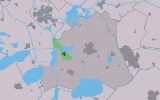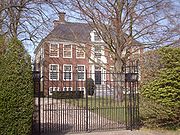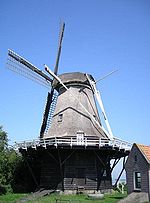
Langweer
Encyclopedia

Friesland
Friesland is a province in the north of the Netherlands and part of the ancient region of Frisia.Until the end of 1996, the province bore Friesland as its official name. In 1997 this Dutch name lost its official status to the Frisian Fryslân...
in the municipality Scharsterland
Skarsterlân
Skarsterlân is a municipality in the province of Friesland in the Netherlands. The municipality was created January 1, 1984 by merging the municipalities of Doniawerstal and Haskerland, the part of Utingeradeel consisting of the villages Akmarijp and Terkaple and the village Nieuwebrug that used...
. The town was established in 1256, and has a population of 964 (as of January 1, 2004).
Langweer has a rich trading
Trade
Trade is the transfer of ownership of goods and services from one person or entity to another. Trade is sometimes loosely called commerce or financial transaction or barter. A network that allows trade is called a market. The original form of trade was barter, the direct exchange of goods and...
history, and it's located at a small lake (Langweerderwielen). Langweer used to only be reached by water. It was backed by swampland. In 1856 it became connected to the outside world by the Brédyk via Sint Nicolaasga
Sint Nicolaasga
Sint Nicolaasga is a village in the Dutch province of Friesland. It is located in the municipality of Skarsterlân, and has about 3270 inhabitants . Until the municipal reorganisation in 1984 Sint Nicolaasga was part of the former municipality Doniawerstal.- History :The oldest listing of the...
. Johan Vegelinsoord of Claerbergen organized this work which involved treeplanting and drainage.
In the 1990s Langweer has become a favorite town of tourist
Tourism
Tourism is travel for recreational, leisure or business purposes. The World Tourism Organization defines tourists as people "traveling to and staying in places outside their usual environment for not more than one consecutive year for leisure, business and other purposes".Tourism has become a...
s because of its picturesque streets and watersport opportunities. One of its main events is Skutsjesilen, a sailing
Sailing
Sailing is the propulsion of a vehicle and the control of its movement with large foils called sails. By changing the rigging, rudder, and sometimes the keel or centre board, a sailor manages the force of the wind on the sails in order to move the boat relative to its surrounding medium and...
race that takes place every summer.
The name Langweer derives from the Frisian name Langwar. War is an old Frisian term for a parcel of land (like English ward) so the name meant long lots, for the shape of the paddocks.
The village symbol which is found on the flag is a swan, possibly derived from the right of farmers to shoot swans.
Regions
The Weversstreek was a street where weavers lived. This is the oldest part of the town. The block between Weversstreek and Stevenshoek used to be full of one room workers cottages.Between Langweerder Wielen (the lake) and Weversstreek and the Buorren (a street) was a zone called De Greate Gaest. Originally this was a meadow. From 1907 to 1965 the Van Der Leij factory operated, drying grass, and pressing oil. This became the De Greate Gaest cafe, and later a service centre. The buildings were demolished in the 1990s to make way for a waterside housing development.
Buildings
Important buildings include the Hervormde Kerk (Dutch Reformed ChurchDutch Reformed Church
The Dutch Reformed Church was a Reformed Christian denomination in the Netherlands. It existed from the 1570s to 2004, the year it merged with the Reformed Churches in the Netherlands and the Evangelical Lutheran Church in the Kingdom of the Netherlands to form the Protestant Church in the...
) of Langweer built in 1777 on the site of three earlier churches. This church is unusually decorated compared to others from the 18th century, and has a swan on its spire. Inside is one of the best church organs in Friesland, constructed by Lambertus van Dam in 1784. A five paneled pulpit was preserved from the previous building. This dates from 1684 and made by Benedictus Jans. The earliest church was built around 1200, but deliberately burned down in 1517 by invaders. There was an unsuccessful attempt to rebuild from the remains. A successfully built half sized church appeared in 1663.

Grietman
A grietman is partly a forerunner of the current rural mayor in the province of Friesland, and partly the forerunner of a judge. The area of jurisdiction was the municipality or gemeente...
of Doniawerstal
Doniawerstal
Doniawerstal was a municipality in southwest Friesland, south of Sneek. It consisted mainly of grassland and lakes. Its capital was Langweer. The municipality was dissolved in 1984; part went to Wymbritseradiel and part went to Skarsterlân. At the time of its dissolution it had its Dutch name; in...
(Mayor) from 1619 to 1652. It lies to the north of the church. It became the town hall for the municipality. In 1829 the last grietman to live there, Schelte Hessel Roorda of Eysinga locked up the building and left it for thirty years. In 1860 it was found to be untouched with clothes lying on the floor and cups on the table. But was demolished and rebuilt in 1939. Langmeer is no longer the municipal capital, so there is no longer a town hall.
The Orangerie was a farm house that featured exotic plants and flowers. It was on the side of the cross town Wymerts canal, which is now filled in.
On the west side of the town was another farmhouse called Douma State. It dates from the sixteenth century. It included another two buildings, the Vechthuis (battle house) and the Douma Stins, which was burned down by Burgundian
Duchy of Burgundy
The Duchy of Burgundy , was heir to an ancient and prestigious reputation and a large division of the lands of the Second Kingdom of Burgundy and in its own right was one of the geographically larger ducal territories in the emergence of Early Modern Europe from Medieval Europe.Even in that...
soldiers in 1517. The farm house was demolished in 1845, but rebuilt in part as an inn called Het Wapen van Friesland. It became a dairy
Dairy
A dairy is a business enterprise established for the harvesting of animal milk—mostly from cows or goats, but also from buffalo, sheep, horses or camels —for human consumption. A dairy is typically located on a dedicated dairy farm or section of a multi-purpose farm that is concerned...
, which was later merged with the milk factory at St. Nicolaasga
Sint Nicolaasga
Sint Nicolaasga is a village in the Dutch province of Friesland. It is located in the municipality of Skarsterlân, and has about 3270 inhabitants . Until the municipal reorganisation in 1984 Sint Nicolaasga was part of the former municipality Doniawerstal.- History :The oldest listing of the...
. The Herberg De Wielen is located here.

Tanning
Tanning is the making of leather from the skins of animals which does not easily decompose. Traditionally, tanning used tannin, an acidic chemical compound from which the tanning process draws its name . Coloring may occur during tanning...
developed in the town to make money off the farmers. After this it was used as a warehouse and then as a hairdresser
Barber
A barber is someone whose occupation is to cut any type of hair, and to shave or trim the beards of men. The place of work of a barber is generally called a barbershop....
.
Regt Huys was a courthouse built around 1600. A judge sat there every Thursday. It was rebuilt in 1766 with original wood used to construct a holding cell
Prison
A prison is a place in which people are physically confined and, usually, deprived of a range of personal freedoms. Imprisonment or incarceration is a legal penalty that may be imposed by the state for the commission of a crime...
in the tower. Later it was used as the town hall for Doniawerstal
Doniawerstal
Doniawerstal was a municipality in southwest Friesland, south of Sneek. It consisted mainly of grassland and lakes. Its capital was Langweer. The municipality was dissolved in 1984; part went to Wymbritseradiel and part went to Skarsterlân. At the time of its dissolution it had its Dutch name; in...
until 1940. During world war II it was a distribution centre for ration tokens. In the late 2000s the building operated as a library.

Windmill
A windmill is a machine which converts the energy of wind into rotational energy by means of vanes called sails or blades. Originally windmills were developed for milling grain for food production. In the course of history the windmill was adapted to many other industrial uses. An important...
De Sweachmermolen
De Sweachmermolen, Langweer
De Sweachmermolen is a smock mill between Langweer and Boornzwaag, Friesland, Netherlands which was built in 1782. The mill has two functions: it is a drainage mill and a corn mill. It has been restored to working order as a drainage mill and is listed as a Rijksmonument, number 13241.-History:De...
is a combined corn mill
Gristmill
The terms gristmill or grist mill can refer either to a building in which grain is ground into flour, or to the grinding mechanism itself.- Early history :...
and drainage mill
Windpump
A windpump is a windmill used for pumping water, either as a source of fresh water from wells, or for draining low-lying areas of land. Once a common fixture on farms in semi-arid areas, windpumps are still used today where electric power is not available or too expensive.-History:Windmills were...
. It has been restored so that it can function as a drainage mill and is held in reserve for use in times of emergency. The mill is also used as a holiday home
Vacation property
Vacation property is a niche in the real estate market dealing with residences used for holiday vacations . In the United Kingdom this type of property is usually termed a holiday home, in Australia, a holiday house/home, or weekender, in New Zealand, a bach or crib...
.

